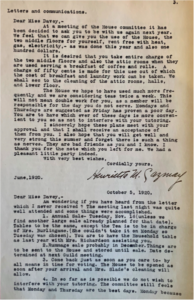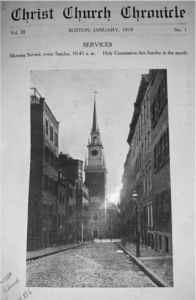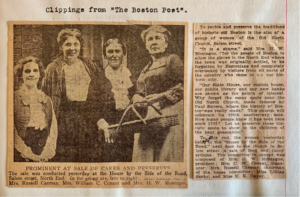The Women of Old North, Part II: The House by the Side of the Road
By Alexandra Moleski
The story of the Women’s Guild founding and function demonstrates the ways in which the organization benefited the institution of the church itself. However, in order to grasp the positive impact that the guild had on the Boston community, one must turn to the story of the House by the Side of the Road, a project started by the guild in 1919, which aimed to reinvent the Parish House as a hospitality house for both members of the community and visitors to the church, as well as establish Old North as a hub for social activity in the North End.
Before the Parish House became the House by the Side of the Road, it was known for providing a warm welcome, entertainment, and overnight accommodation to servicemen visiting the church. Soldiers and sailors arrived from various other states, from Rhode Island to Nevada, and even other countries like France and Italy to witness the famed landmark. The women of Old North treated servicemen to luncheons and tours of the church, in hopes of making the “little house an adventure in Friendship for [the] boys.” Upon hosting an increasing number of military visitors and seeing the friendships forged between people from vastly different backgrounds within the walls of the Parish House, the Women’s Guild was inspired to open its doors to the American public. They sought to establish Old North as the heart of the North End community—a space where churchgoers could pray, neighbors socialize, and visitors absorb the patriotic history of Boston. The vision of the project could be best summarized in the words of Louise W. Montague, the first president of the guild:
The Women’s Guild of Christ Church are planning to make the parish House (which adjoins the church), a sort of historic centre, and a place for inspiration and help to the workers and friends of the North End…We wish to widen the church’s usefulness, to do historic and patriotic work and help in Americanization in a broader sense. We feel the church can be made to play a vital part in this new era on which our country is entering, and “The little house by the side of the road” can be a Friend to Man and spokesman for the silent but appealing ancient Church.

The House by the Side of the Road officially opened on March 19, 1919. As the first Resident at the house, Mary Kent Davey Babcock quickly became one of the prominent faces of the project. In exchange for $100 annually and the opportunity to reside in the Parish House “rent free with heat, gas, [and] electricity,” it was her duty to maintain the house and act as hostess, attending to “any who might use the upper rooms [including] supplying a breakfast of coffee & rolls.” From the beginning, the endeavor proved successful and its impact on the Boston populace wholly positive. The social events and charity work organized by the guild unified the community and provided support to those in need, while the preservation efforts cemented Old North as a historically and culturally significant site in the modern era.
The Parish House frequently hosted gatherings such as tea parties, luncheons, and wedding and funeral receptions for its many visitors from various corners of the world. Soldiers and sailors continued to make pilgrimages to the church. For example, during the same month that the House by the Side of the Road was founded, French sailors “in their snug blue uniforms and close round caps with red pompoms” visited Old North and “accepted the hospitality of [the] Parish House,” while giving the Women’s Guild a “glimpse into their lives and a closer view of the unconquerable spirit of France.” Later that year, the House by the Side of the Road also entertained 25 female Chinese exchange students, hosting a tea party and giving them a tour of the Parish House and church. During a particularly brutal storm in February 1920, the House by the Side of the Road even served as a shelter for several women, including a teacher in the North End, who were unable to reach their own homes. The Women’s Guild also continued hosting fairs and sales, either using the profits to fund the House by the Side of the Road itself or donating them to charitable causes outside the church.
 In addition to the social work in which the Women’s Guild was involved, the organization strived to preserve the rich history of the church and the Boston area. For instance, a copy of the Christ Church Chronicle from December 1919 encourages readers to donate “pictures, prints, maps, or literature pertaining to the old days when the North End was a fine residential section.” At the forefront of such preservation efforts was Mary Kent Davey Babcock. She was the author of several historical works, including a piece entitled Christ Church, Salem Street, Boston: The Old North Church of Paul Revere Fame: Historical Sketches, Colonial Period 1723-1775. In a publication of the Chronicle from April 1919, she announces the guild’s acquisition of a woodcut of Mademoiselle Clairon, an eighteenth-century French actress, carved by Paul Revere, and encourages all members of the church to visit the artifact on the third floor of the Parish House. The aim of the guild’s historic preservation was to inspire a sense of patriotism and unity in the aftermath of the First World War.
In addition to the social work in which the Women’s Guild was involved, the organization strived to preserve the rich history of the church and the Boston area. For instance, a copy of the Christ Church Chronicle from December 1919 encourages readers to donate “pictures, prints, maps, or literature pertaining to the old days when the North End was a fine residential section.” At the forefront of such preservation efforts was Mary Kent Davey Babcock. She was the author of several historical works, including a piece entitled Christ Church, Salem Street, Boston: The Old North Church of Paul Revere Fame: Historical Sketches, Colonial Period 1723-1775. In a publication of the Chronicle from April 1919, she announces the guild’s acquisition of a woodcut of Mademoiselle Clairon, an eighteenth-century French actress, carved by Paul Revere, and encourages all members of the church to visit the artifact on the third floor of the Parish House. The aim of the guild’s historic preservation was to inspire a sense of patriotism and unity in the aftermath of the First World War.

The House by the Side of the Road allowed the Women’s Guild an opportunity to support not only the Old North Church itself, but also the entirety of the Boston community. Through the charity work and historic and cultural preservation that emerged from the Parish House beginning in 1919, the guild simultaneously established Old North as a thriving communal space and gave back to the surrounding community.
End Notes
